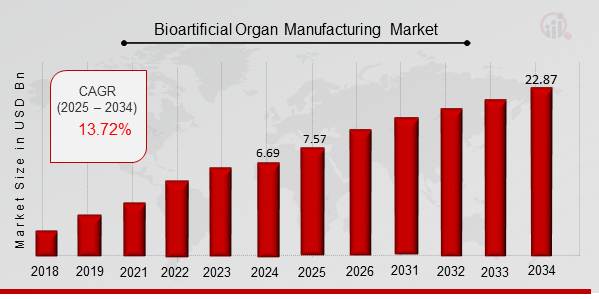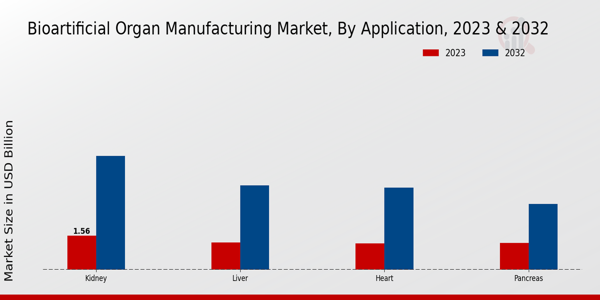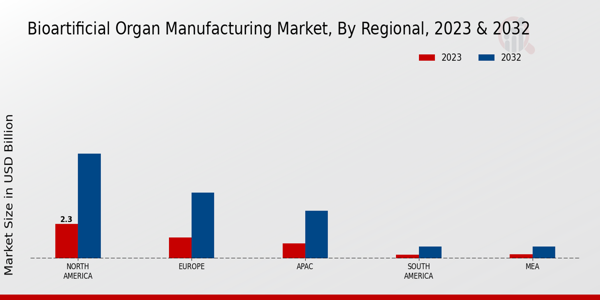Bioartificial Organ Manufacturing Market Overview
As per MRFR analysis, the Bioartificial Organ Manufacturing Market Size was estimated at 6.69 (USD Billion) in 2024. The Bioartificial Organ Manufacturing Market Industry is expected to grow from 7.57 (USD Billion) in 2025 to 22.87 (USD Billion) till 2034, at a CAGR (growth rate) is expected to be around 13.07% during the forecast period (2025 - 2034).
Key Bioartificial Organ Manufacturing Market Trends Highlighted
The Bioartificial Organ Manufacturing Market is experiencing significant growth driven by an increasing prevalence of chronic diseases and shortages of organ donors. Advances in biotechnology and materials science play crucial roles in developing bioartificial organs that can effectively mimic the function of natural organs. This growing awareness surrounding the potential of bioartificial organs to address these shortages fosters a supportive environment for investment and innovation in this field.
The opportunities to be explored are vast, particularly in regenerative medicine and transplant technology. As researchers continue to improve the design and functionality of bioartificial organs, partnerships between academic institutions and industry stakeholders become essential. These collaborations can lead to breakthroughs in organ manufacturing techniques and improvements in patient outcomes.
Moreover, the expanding interest in personalized medicine can drive the demand for custom bioartificial organs tailored to individual patient needs. Recently, trends indicate an increasing focus on ethical considerations surrounding organ manufacturing. As society grapples with the implications of biotechnology, there is a push for transparency and accountability in the development and commercialization of bioartificial organs.
Additionally, there is a rise in research aimed at creating organs that can integrate seamlessly with the human body, enhancing their viability and efficacy. The integration of digital health technologies into the development process further highlights the trend towards smart, interconnected devices that can monitor organ function in real-time. Overall, the landscape of the Bioartificial Organ Manufacturing Market offers promising avenues for innovation, collaboration, and improved health outcomes.

Source: Primary Research, Secondary Research, MRFR Database and Analyst Review
Bioartificial Organ Manufacturing Market Drivers
Increasing Prevalence of Chronic Diseases
The rise in chronic diseases, such as diabetes, kidney failure, and heart diseases, is a significant driver for the Bioartificial Organ Manufacturing Market Industry. As the global population ages, the incidence of these conditions is expected to rise, leading to an increasing need for organ replacements or supportive therapies. Bioartificial organs emerge as a technologically advanced solution to address organ shortages and enhance patient outcomes.
These organs are designed to mimic the functions of natural organs, making them pivotal in the long-term treatment of chronic illnesses. The healthcare sector is increasingly focusing on innovative solutions to manage the complications arising from chronic conditions effectively. Furthermore, advancements in bioengineering and tissue engineering play a transformative role in the development of these organs, paving the way for more efficient and biocompatible options that are suitable for implantation.
Increased public awareness about organ transplants and ongoing research initiatives fuel investments in this area, contributing to the robust growth forecasted for the Bioartificial Organ Manufacturing Market.
Technological Advancements in Bioengineering
Technological advancements in bioengineering are rapidly transforming the landscape of the Bioartificial Organ Manufacturing Market Industry. Innovations in biomaterials, 3D bioprinting, and stem cell technologies have significantly improved the fabrication of bioartificial organs. These technologies enable the creation of organs that not only closely resemble natural anatomy but also perform vital physiological functions.
The integration of smart biomaterials that can interact with host tissues is paving the way for more successful outcomes in organ transplantation, thus driving demand in the market. Continuous research and development are crucial as they enhance the functionality and compatibility of these organs, ultimately leading to improved patient care.
Growing Investment in Regenerative Medicine
The growing investment in regenerative medicine is creating a favorable environment for the expansion of the Bioartificial Organ Manufacturing Market Industry. Governments, private entities, and healthcare organizations are channeling funds into research and development for new therapeutic strategies. The promising potential of bioartificial organs in regenerative therapies has attracted interest from various stakeholders, leading to collaborations aimed at accelerating product development. This influx of investments is essential for advancing technologies and launching innovative products that can effectively address organ shortages and improve patient outcomes.
Bioartificial Organ Manufacturing Market Segment Insights:
Bioartificial Organ Manufacturing Market Application Insights
The Bioartificial Organ Manufacturing Market, focusing on the Application segment, is witnessing notable growth, with a market valuation expected to reach 5.23 USD Billion in 2023 and escalating to 22.87 USD Billion by 2034. This robust increase reflects a significant average growth forecast for the entire market. Within this segment, the revenue is categorized primarily into four major applications: Kidney, Liver, Heart, and Pancreas, each contributing distinctly to this burgeoning market.
The Kidney application holds a majority share, valued at 1.56 USD Billion in 2023 and projected to rise to 5.2 USD Billion by 2032, indicating its vital role in addressing the critical and growing demand for renal replacement therapies due to rising incidences of kidney diseases worldwide. Following closely, the Liver application, valued at 1.25 USD Billion in 2023 and expected to reach 3.85 USD Billion by 2032, emphasizes the importance of addressing liver function failure, which remains a pressing health concern given the increasing cases of liver cirrhosis and hepatitis.
The Heart application, primarily valued at 1.2 USD Billion in 2023 and projected to grow to 3.75 USD Billion by 2032, underscores the ongoing need for bioartificial solutions to tackle heart-related ailments prevalent across various age demographics. Lastly, the Pancreas application, with a valuation of 1.22 USD Billion in 2023, anticipated to grow to 3.0 USD Billion by 2032, addresses the growing rates of diabetes and its complications by offering innovative solutions for insulin production and regulation.
The trends in the Bioartificial Organ Manufacturing Market demonstrate an increasing preference for organ substitutes due to the shortage of donor organs and the rising incidence of organ failures, which presents a significant opportunity for market players. However, challenges such as regulatory hurdles and high manufacturing costs may influence market dynamics. The segmentation of the Bioartificial Organ Manufacturing Market reveals important insights into the rising demand for bioengineered organs, contributing to the overall growth and driving innovation in the healthcare sector while presenting substantial opportunities for advancements in medical technology and patient care.

Source: Primary Research, Secondary Research, MRFR Database and Analyst Review
Bioartificial Organ Manufacturing Market Technology Insights
The Bioartificial Organ Manufacturing Market within the Technology segment is poised for significant growth, with a market value expected to reach 5.23 billion USD in 2023 and surging to 22.87 billion USD by 2034. Key contributors driving this expansion include advanced methodologies such as 3D Bioprinting, Stem Cell Technology, and Tissue Engineering. 3D Bioprinting plays a crucial role in creating custom tissues and organs, enabling precision medicine solutions, while Stem Cell Technology is foundational for regenerating damaged tissues, thus offering hope for numerous medical conditions.
Tissue Engineering dominates the landscape by combining biological and engineering principles to design functional tissues, addressing the growing demand for organ transplantation. The continuous evolution of these technologies is propelled by increased investment in research and development, alongside a rising prevalence of organ failure diseases. However, challenges such as regulatory hurdles and ethical concerns around stem cell use remain prevalent.
Nevertheless, these innovative approaches present ample opportunities for market players, creating a favorable environment for the Bioartificial Organ Manufacturing Market revenue growth. Key insights from Bioartificial Organ Manufacturing Market data reveal a strong potential for each technology to address critical healthcare challenges, thus shaping the future of medical treatments.
Bioartificial Organ Manufacturing Market Material Type Insights
The Bioartificial Organ Manufacturing Market, valued at 5.23 billion USD in 2023, is experiencing a significant growth trajectory, with various material types playing critical roles. Among these, Synthetic Polymers are crucial due to their versatility and biocompatibility, making them a favorable choice in applications that require customization and durability. Natural Biomaterials are also gaining traction as they align closely with biological systems and promote natural healing processes, thus enhancing organ functionality. Composites, combining the properties of both synthetic and natural materials, offer enhanced strength and performance, making them essential in complex organ structures.
The market growth is propelled by increasing clinical applications and technological advancements, while the challenge remains in ensuring compatibility and minimizing rejection rates. Overall, the segmentation of the Bioartificial Organ Manufacturing Market not only highlights the significance of these materials but also points to a promising future where innovations could lead to better patient outcomes and expanded applications.
Bioartificial Organ Manufacturing Market End Use Insights
The Bioartificial Organ Manufacturing Market, valued at approximately 5.23 billion USD in 2023, showcases a diverse landscape in its End Use segment, which significantly drives market dynamics. Within this realm, hospitals emerge as a crucial player, facilitating the application of bioartificial organs in patient care and treatment, thus leading to enhanced patient outcomes and operational efficiencies. Research institutes play a vital role as well, serving as innovation hubs that contribute to the development and testing of new technologies, thereby fostering scientific advancements and pushing regulatory boundaries.
Pharmaceutical companies are integral to this ecosystem, leveraging bioartificial organs for drug testing and personalized medicine, which streamlines the drug development process and increases efficacy. The collaboration among these entities is vital for shaping the future of the Bioartificial Organ Manufacturing Market, presenting numerous opportunities as healthcare demands evolve. Overall, the End Use landscape illustrates the market growth driven by a commitment to innovation, patient-centric solutions, and continuous improvement in healthcare outcomes. Exploring the Bioartificial Organ Manufacturing Market statistics further illuminates the growing significance of this sector, compelling industry stakeholders to engage actively in its evolution.
Bioartificial Organ Manufacturing Market Regional Insights
In 2023, the Bioartificial Organ Manufacturing Market was valued at 5.23 USD Billion, showcasing significant interest across various regions. North America holds a majority share, valued at 2.3 USD Billion, with a projected growth to 7.0 USD Billion by 2032, driven by advanced research facilities and technological innovation. Europe follows, holding significant value at 1.4 USD Billion in 2023 and expected to reach 4.4 USD Billion, reflecting strong regulatory support and an increasing focus on regenerative medicine.
The APAC region, valued at 1.0 USD Billion, is emerging as a significant player due to rising healthcare expenditures and growing awareness, projected to reach 3.2 USD Billion by 2032.
South America and MEA represent smaller segments, with valuations of 0.25 USD Billion and 0.28 USD Billion, respectively, in 2023, but both regions are anticipated to see increased investments in healthcare infrastructure, potentially enhancing their market presence in the future. Overall, the Bioartificial Organ Manufacturing Market segmentation indicates robust growth opportunities driven by technological advancements and increased demand for organ transplants across regions.

Source: Primary Research, Secondary Research, MRFR Database and Analyst Review
Bioartificial Organ Manufacturing Market Key Players and Competitive Insights:
The Bioartificial Organ Manufacturing Market is influenced by a variety of dynamics that stem from advancements in biotechnology, biomaterials, and tissue engineering. This market is characterized by rapid evolution and intense competitiveness, driven by the pressing demand for organ transplants, the increasing prevalence of chronic diseases, and extensive research activities dedicated to developing functional bioartificial organs. Companies strive to innovate and improve production processes, enhance organ functionality, and ensure biocompatibility. Competitive strategies involve collaborations, mergers, and technological advancements aimed at securing a significant market share.
The presence of established players alongside startups creates a diverse landscape that fosters innovation while maintaining a focus on quality and regulatory compliance.
Tissue Regenerative Therapies stands out within the Bioartificial Organ Manufacturing Market due to its commitment to pioneering advancements in tissue engineering and regenerative medicine. This company harnesses cutting-edge technologies and methodologies to develop bioartificial organs that closely mimic the physiological characteristics of human tissues and organs. Its emphasis on research and development not only elevates its competitive positioning but also underscores the company's ability to respond rapidly to the changing needs of patients and healthcare providers.
Key strengths of Tissue Regenerative Therapies lie in its strong intellectual property portfolio, which enhances its market presence, and its collaboration with leading research institutions that bolster its innovation pipeline. Moreover, the firm’s robust clinical trial programs signify its commitment to safety and efficacy, further enhancing its reputation within this highly specialized market.
Eden Technologies is also a key player in the Bioartificial Organ Manufacturing Market, focusing on the development of proprietary bioengineering solutions tailored for organ manufacturing. This company emphasizes the creation of scalable manufacturing processes that not only improve production efficiency but also ensure high-quality output of bioartificial organs. Eden Technologies distinguishes itself through its unique approach to integrating biocompatible materials that enable optimal cellular integration and functionality. The company has forged significant partnerships with healthcare facilities and academic institutions, enhancing its credibility and expanding its capabilities in the field.
By investing in innovative technologies and maintaining a strong commitment to patient outcomes, Eden Technologies is positioned well to capture increasing market demand and establish a strong foothold within the bioartificial organ landscape. Its forward-thinking strategies and dedication to quality make it a formidable competitor in this burgeoning market segment.
Key Companies in the Bioartificial Organ Manufacturing Market Include:
- Tissue Regenerative Therapies
- Eden Technologies
- Smith and Nephew
- TransMedics
- Tremont Medical
- Sernova Corp
- Acelity
- Organogenesis
- Fidia Farmaceutici
- Medtronic
- Vericel Corporation
- Fresenius Medical Care
- Regen Medical
- Axovant Gene Therapies
- Cynata Therapeutics
Bioartificial Organ Manufacturing Market Industry Developments
Recent developments in the Bioartificial Organ Manufacturing Market have seen significant advancements, particularly with companies such as Tissue Regenerative Therapies, Eden Technologies, and Medtronic enhancing their R&D capabilities to innovate bioengineering techniques. Notably, TransMedics has been expanding its transplantation supply chain, facilitating quicker organ delivery mechanisms. Sernova Corp is gaining attention for its promising results in cell encapsulation technology, which aims to eliminate the need for long-term immunosuppression.
Merger and acquisition activity has also been notable, with Acelity announcing plans to consolidate resources with Fresenius Medical Care to bolster their regenerative product lines. Meanwhile, Vericel Corporation and Regen Medical have entered into collaborative agreements aimed at liposomal formulations for improved organ preservation. The market is witnessing growth in valuation due to increasing investments in bioprinting technologies and regulatory support for innovative organ solutions, with companies like Axovant Gene Therapies and Cynata Therapeutics leading the charge in gene therapy applications for organ failure treatments.
These developments collectively signal a dynamic shift towards more advanced, patient-centric solutions in the bioartificial organ arena.
Bioartificial Organ Manufacturing Market Segmentation Insights
Bioartificial Organ Manufacturing Market Application Outlook
- Kidney
- Liver
- Heart
- Pancreas
Bioartificial Organ Manufacturing Market Technology Outlook
Bioartificial Organ Manufacturing Market Material Type Outlook
- Synthetic Polymers
- Natural Biomaterials
- Composites
Bioartificial Organ Manufacturing Market End Use Outlook
- Hospitals
- Research Institutes
- Pharmaceutical Companies
Bioartificial Organ Manufacturing Market Regional Outlook
- North America
- Europe
- South America
- Asia Pacific
- Middle East and Africa
| Report Attribute/Metric |
Details |
| Market Size 2024 |
6.69 (USD Billion) |
| Market Size 2025 |
7.57 (USD Billion) |
| Market Size 2034 |
22.87 (USD Billion) |
| Compound Annual Growth Rate (CAGR) |
13.07 % (2025 - 2034) |
| Report Coverage |
Revenue Forecast, Competitive Landscape, Growth Factors, and Trends |
| Base Year |
2024 |
| Market Forecast Period |
2025 - 2034 |
| Historical Data |
2020 - 2024 |
| Market Forecast Units |
USD Billion |
| Key Companies Profiled |
Tissue Regenerative Therapies, Eden Technologies, Smith and Nephew, TransMedics, Tremont Medical, Sernova Corp, Acelity, Organogenesis, Fidia Farmaceutici, Medtronic, Vericel Corporation, Fresenius Medical Care, Regen Medical, Axovant Gene Therapies, Cynata Therapeutics |
| Segments Covered |
Application, Technology, Material Type, End Use, Regional |
| Key Market Opportunities |
Regenerative medicine advancements, Increased organ transplant demand, Technological innovations in bioengineering, Rising investment in R, Growing aging population requiring solutions |
| Key Market Dynamics |
Technological advancements, Rising organ transplantation demand, Increased investment in R, Growing prevalence of chronic diseases, Regulatory challenges and compliance |
| Countries Covered |
North America, Europe, APAC, South America, MEA |
Frequently Asked Questions (FAQ):
The Bioartificial Organ Manufacturing Market is expected to be valued at 22.87 USD Billion by the year 2034.
The market is expected to grow at a CAGR of 13.07% from 2025 to 2034.
North America is expected to hold the largest market share, projected to be valued at 7.0 USD Billion by 2032.
The market size for the Kidney application is expected to reach 5.2 USD Billion by 2032.
Key players in the market include Tissue Regenerative Therapies, Eden Technologies, and Medtronic, among others.
The market size for the Liver application is projected to be 3.85 USD Billion by 2032.
South America is anticipated to have the smallest market share, projected to reach 0.8 USD Billion by 2032.
The market value of the Heart application in 2023 is estimated to be 1.2 USD Billion.
The market size for the Pancreas application is expected to reach 3.0 USD Billion by 2032.
The APAC region is expected to reach a market value of 3.2 USD Billion by 2032.

















